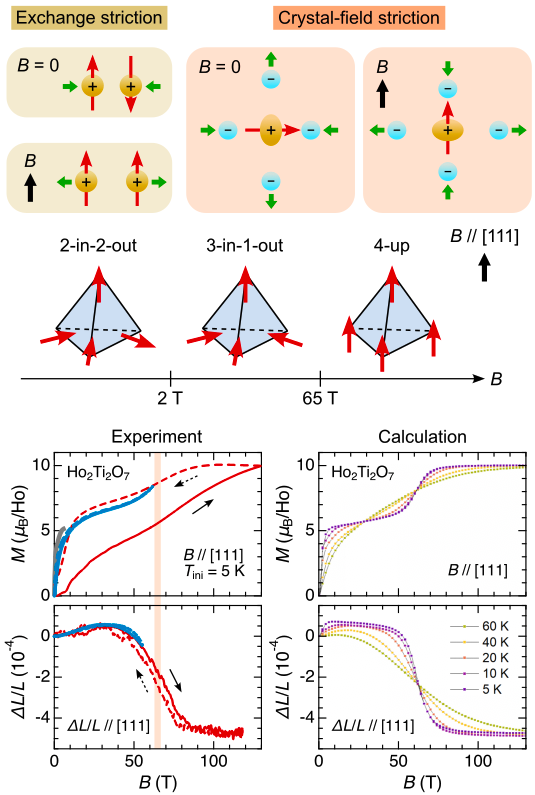Observation of crystal-field magnetostriction in a spin-ice compound
The emergence of lattice strain upon applying a magnetic field is known as magnetostriction. In magnetic materials, the origin of magnetostriction can be divided primarily into two mechanisms: exchange striction, arising from the distance dependence of exchange interactions, and crystal-field striction, originating from deformations of electronic orbitals due to mixing of crystal-field levels. Although magnetostriction is a powerful probe for detecting magnetic phase transitions, its behavior is not straightforward to predict, and its theoretical description is nontrivial.
We focused on the prototypical classical spin-ice compound Ho2Ti2O7. Under external fields of only 2 T, it undergoes a transition from the 2-in-2-out state to a 3-in-1-out (or 1-in-3-out) configuration, whereas applying much higher megagauss fields drives the system through a crystal-field level crossing into a forced-ferromagnetic 4-up state. Since exchange striction and crystal-field striction manifest in markedly different field ranges, ultrahigh magnetic fields provide a means to disentangle and observe these two contributions separately in Ho2Ti2O7.
In this study, we applied magnetic fields up to 120 T along the [111] direction of Ho2Ti2O7 and measured magnetostriction using the FBG technique. We found that, while the low-field regime exhibits positive magnetostriction, a much larger negative magnetostriction of order 10-4 appears around 65 T, where a crystal-field level crossing occurs. To understand this behavior, we performed numerical simulations of magnetostriction using the McPhase package. Starting from a point-charge model and incorporating distance-dependent exchange interactions as well as crystal-field-phonon coupling, we carried out mean-field calculations and successfully reproduced the complex magnetostriction bevahior observed experimentally. This combined approach, i.e., ultrahigh-field experiments together with numerical simulation, can be broadly applied to a wide range of materials (particularly 4f-electron systems) and is expected to yield deeper insight into magnetostriction phenomena.
We focused on the prototypical classical spin-ice compound Ho2Ti2O7. Under external fields of only 2 T, it undergoes a transition from the 2-in-2-out state to a 3-in-1-out (or 1-in-3-out) configuration, whereas applying much higher megagauss fields drives the system through a crystal-field level crossing into a forced-ferromagnetic 4-up state. Since exchange striction and crystal-field striction manifest in markedly different field ranges, ultrahigh magnetic fields provide a means to disentangle and observe these two contributions separately in Ho2Ti2O7.
In this study, we applied magnetic fields up to 120 T along the [111] direction of Ho2Ti2O7 and measured magnetostriction using the FBG technique. We found that, while the low-field regime exhibits positive magnetostriction, a much larger negative magnetostriction of order 10-4 appears around 65 T, where a crystal-field level crossing occurs. To understand this behavior, we performed numerical simulations of magnetostriction using the McPhase package. Starting from a point-charge model and incorporating distance-dependent exchange interactions as well as crystal-field-phonon coupling, we carried out mean-field calculations and successfully reproduced the complex magnetostriction bevahior observed experimentally. This combined approach, i.e., ultrahigh-field experiments together with numerical simulation, can be broadly applied to a wide range of materials (particularly 4f-electron systems) and is expected to yield deeper insight into magnetostriction phenomena.
References
[A] N. Tang, M. Gen, et al., Phys. Rev. B 110, 214414 (2024). (Original paper [30])
